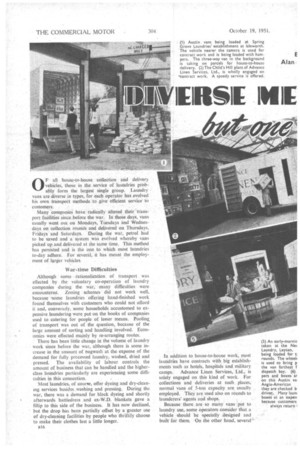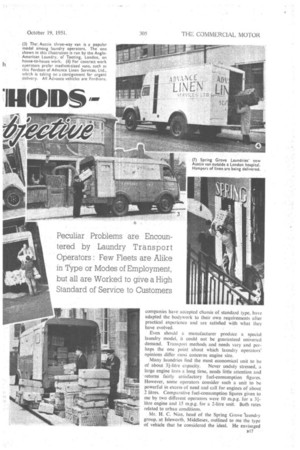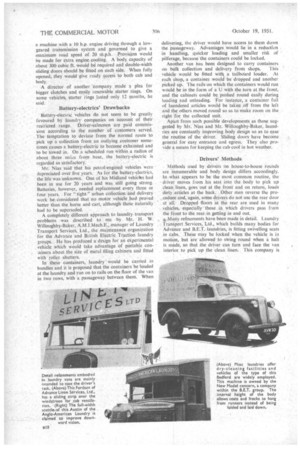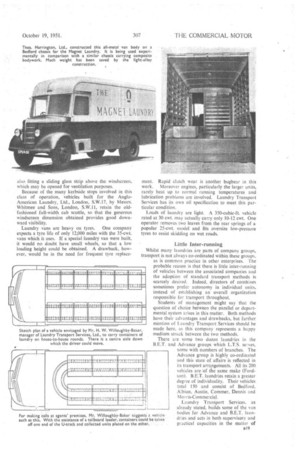MEUSE ME
Page 50

Page 51

Page 52

Page 53

Page 54

If you've noticed an error in this article please click here to report it so we can fix it.
1111010S far
Alan
0F all housc-to-house collection and delivery vehicles, those in the service of laundries probably form the largest single group. Laundry vans are diverse in types, for each operator has evolved his own transport methods to give efficient service to
customers. .
Many companies have radically altered their transport facilities since before the war. In those days, vans usually went out on Mondays, Tuesdays and Wednesdays on collection rounds and delivered on Thursdays, Fridays and Saturdays. During the war, petrol had to be saved and a system was evolved whereby vans picked up and delivered at the same time. This method has persisted and is the one to which most laundries to-day adhere. For several, it has meant the employment of larger vehicles.
War-time Difficulties Although some rationalization of transport was effected by the voluntary co-operation of laundry companies during the war, many difficulties were encountered. Zoning schemes did not work well, because some laundries offering hand-finished work found themselves with customers who could not afford it and, conversely, sonic households accustomed to expensive laundering were put on the books of companies used to catering for people of lesser means. Pooling, of transport was out of the question, because of the large amount of sorting and handling involved. Economies were effected mainly by re-arranging routes.
There has been little change in the volume of laundry work since before the war, although there is some increase in the amount of bagwash at the expense of the demand for fully processed laundry, washed, dried and pressed. The availability of labour controls the amount of business that can be handled and the higherclass laundries particularly are experiencing some diffi culties in this connection. .
Most laundries, of course, offer dyeing and dry-cleaning services besides.washing and pressing. During the war, there was a demand for black dyeing and shortly afterwards battledress and ex-W.D. blankets gave a fillip to this side of the business. It has now declined, but the drop has been partially offset by a 'greater use of dry-cleaning facilities by people who thriftily choose to make their clothes last a little longer.
816
In addition to house-to-house work, most laundries have contracts with big establishments such as hotels, hospitals and military camps. Advance Linen Services, Ltd., is solely engaged on this kind of work. For collections and deliveries at such places, normal vans of 5-ton capacity are usually employed. They are used also on rounds to launderets; agents and shops.
Because there• are so many vans put to laundry use, some operators consider that a vehicle should be specially designed and _ built for them. -On the other hand, several companies have accepted chassis of standard type, have adapted the bodywork to their own requirements after practical experience and are satisfied with what they have evolved.
Even should a manufacturer produce a special laundry model, it could not be guaranteed universal demand. Transport methods and needs vary and perhaps the one point about which laundry operators' opinions differ most concerns engine size.
Many laundries find the most economical unit to be
of about 31-1itre capacity. Never unduly stressed, a large engine lasts a long time, needs little attention and • returns fairly satisfactory fuel-consumption figures. However, some operators consider such a unit to be powerful in excess of need and call for engines of about 2 litres. Comparative fuel-consumption figures given to me by two different operators were 10 m.p.g. for a 3litre engine and 15 m.p.g. for a 2-litre unit. Both rates related to urban conditions.
Mr. H. C. Nias, head of the Spring Grove 'laundry group, at Isleworth, Middlesex, outlined to me the type of vehicle that he considered the ideal. He envisaged all a machine with a 10 h.p. engine driving through a lowgeared transmission system and governed to give a maximum road speed of 20 m.p.h. eroyision would .be made for extra engine cooling. A body capacity of about 300 cubic ft. would be required and double-width sliding doors should be fitted on each side. When fully opened, they would give ready access to both cab and body.
• A director of another -company made a plea for bigger clutches and easily renewable starter rings. On some vehicles; starter rings lasted only 12 months, he said.
Battery-electrics' Drawbacks
• Battery-electric Vehicles do not seem to be greatly favoured by laundry companies on account of their
.restricted range. Driver-salesmen are paid commisSion according to the number of customers served. The temptation to deviate from the normal route to pick up a collection from an outlying customer sometimes causes a battery-electric to become exhausted and to be towed in. On a scheduled run within a radius of about three miks from base, the battery-electric is regarded as satisfactory. .
Mr. Nias .said that his petrol-engined vehicles were depreciated over five years. As for the battery-electrics, the life was unknown. One of his Midland vehieltS had been in use for 20 years and was still going strong. Batteries, however, needed replacement every three or four years. For " tight" urban collection and delivery work he considered that no motor vehicle had proved• better than the horse and cart, although these naturally
had to be superseded. . • . .
A completely different approach to laundry transport problems was described to me -by. Mr. 171. W. Willoughby-Baker, A.M.1.MeehE.., manager of Laundry Transport Services, Ltd., the maintenance organization for the Advance and British Electric Traction laundry groups. He has produced a design for an experimental vehicle which Would take advantage of portable containers about the size of metal filing cabinets and fitted
with roller shutters. .
In these containers, laundry would be Carried in bundles and it is proposed that the containers beloaded at the laundry and run on to rails on the floor of the van in two rows, with a passageway between them. When delivering, the driver would have access to them down the passageway. Advantages would lie in a reduction in handling, quicker loading and smaller risk of pilferage, because the containers could be locked.
Another van has been designed to Carry containers
on bulk collection and delivery from shops. This vehicle would be fitted with, a tailboard loader. At each shop, a container would be dropped and another picked up. The rails on which the containers would run would be in the form of a U with the turn at the front, and the cabinets could be pushed round easily during loading and unloading. For instance, a container full of laundered articles would be taken off from the left and the others moved round so as to make room on the right for the collected unit.
Apart from such possible developments as those suggested by Mr. Nies and Mr. Willoughby-baker, laundries are constantly improving body design so as to case the routine of the driver. Sliding doors have become general for easy entrance and egress. They also provide a means for keeping the cab cool in hot weather.
Drivers' Methods • Methods used by drivers on house-to-house rounds are innumerable and body design differs accordingly. In what appears to be the most common routine, the driver moves from his seat into the body to pick up clean linen, goes out at the front and on return, loads dirty articles at the back. Other men reverse the procedure and, again, some drivers do not use the rear door at all. Dropped floors at the rear are used in many vehicles, especially those in which drivers pass from the front to the rearm n getting in and out.
e Many refinements have been made in detail. Laundry Transport Services, Ltd., which builds many bodies for Advance and B.E.T. laundries, is fitting swivelling seats in cabs. These may be locked when the vehicle is in motion, but are allowed to swing round when a halt is made, so that the driver can turn and face the van interior to pick up the clean linen. This company is also fitting a sliding glass strip above the windscreen, which may be opened for ventilation purposes.
Because of the many kerbside stops involved in this class of operation, vehicles built for the AngloAmerican Laundry, Ltd., London, S.W.17, by Messrs. Whitmee and Sons, London, S.W.11, retain the oldfashioned full-width cab scuttle, so that the generous windscreen dimension obtained Provides good downward visibility.
Laundry vans are heavy on tyres. One company expects a tyre life of only 12,000 miles with the 35-cwt. vans which it uses. If a special laundry van were built, it would no doubt have small wheels, so that 4 low loading height could be obtained. A drawback, however, would be in the need for frequent tyre replace
ment. Rapid clutch wear is another bugbear in this work. Moreover engines, particularly the larger units, rarely heat up to normal running temperatures and lubrication problems are involved. Laundry Transport Services has its own oil specification to meet this particular condition.
Loads of laundry are light. A 350-cubic-ft. vehicle rated at 30 cwt. may actually carry only 1042 cwt. One operator removes two leaves from the rear springs of a popular 25-cwt. model and fits oversize low-pressure tyres to resist skidding on wet roads.
Little Inter-running
Whilst many laundries are parts of company groups, transport is not always co-ordinated within these groups, as is common practice in other enterprises. The probable reason is that there is little inter-running of vehicles between the associated companies and the adoption of standard transport methods is scarcely desired, Indeed, directors of combines sometimes prefer autonomy in individual units, instead of establishing an overall organization responsible for transport throughout.
Students of management might say that the question of choice between the parallel or depa rimental system arises in this matter. Both methods have their advantages and drawbacks, but further mention of La undry Transport Services should be made here, as this cornpany represents a happy medium struck between the two methods.
There are some two dozen laundries in the
B.E.T. and Advance groups which L.T.S. serves, some with numbers-of branches. The Advance group is highly co-ordinated and this state of affairs is reflected in its transport arrangements. All-its 200 vehicles are of the same make (Fordson). B.E.T. laundries retain a greater degree of individuality. Their vehicles total 150 and consist . of Bedford. Albion, Austin, Commer, Dennis and
Morris-Commercial.
Laundry Transport Services, as already stated, builds some of the van bodies for Advance and B.E.T. laundries and acts in both supervisory and practical capacities in the matter of
vehicle maintenance. Major overhauls to all vans are done at its Putney workshops and L.T.S. inspectors regularly Visit branch laundries to check the state of the vehicles. As an inspector it acts not as a disciplinary body but as an adviser to the group management. The company collates details and statistics of all transport activities, so as to have a general picture of affairs and be able to give well-founded guidance on transport matters. it also maintains a pool of reserve vans which are sent out to replace those brought in for service Operations.
In those groups where a fuller degree of responsibility is left in the hands of local branch managers, great advantage is often taken of the service facilities of motor and tyre manufacturers. One London group set up a central maintenance workshop, but found that the size of the fleet did not justify its establishment and it was abandoned.
Small Fleets The tinall size of group fleets often explains the absence of co-ordinated operational and service arrangements in transport. In any event, transport is only part of a laundry's activities and supervision can effectively be carried out by normal departmental means. A motor foreman, under the branch manager, is fully capable of seeing that vans are well looked after and any overseeing from " next highest formation" may not be 'necessary.
On laundry work, mileages run are not high. The • average is 'about 150 miles a week on house-to-house routine. The Times laundry fleet of over 100 vans of different makes, covers about 750,000 miles each year; in which period 2m. parcels are handled. This concern's statistics show that 40 collections and deliveries are made for each gallon of petrol consumed at an average 15 m.p.g. • Transport expenses work out to about 12 per cent. of a laundry's turnover, and great importance is attached to efficiency. Vans and drivers are a laundry's contacts with customers and must therefore be of the same standard as the services offered. Drivers can earn 50 per cent. above their basic wage On commission and a good man can collect £9 10s. a week.
Staff Selection Selection of staff is often difficult; for men must be highly trustworthy. One Spring Grove driver proudly carries 30 latchkeys with him, given by housewives in case they should be out when he calls. A laundry cannot always place the same degree of faith in its customers, who often fail to return the fibreboard cases in which clean linen is delivered by some concerns, These cases cost about 14s. each, but any system for checking their number periodically is more expensive than the rate of loss. Spring Grove laundry is marking boxes with lines of different colours, but the efficacy of this method has yet to be proved. The problem is one which can probably be overcome only by the creation of strong goodwill between laundry and customer. Working in keen competition, laundry companies look to efficient collection and delivery services as a" major means for establishing this goodwill.




































































































